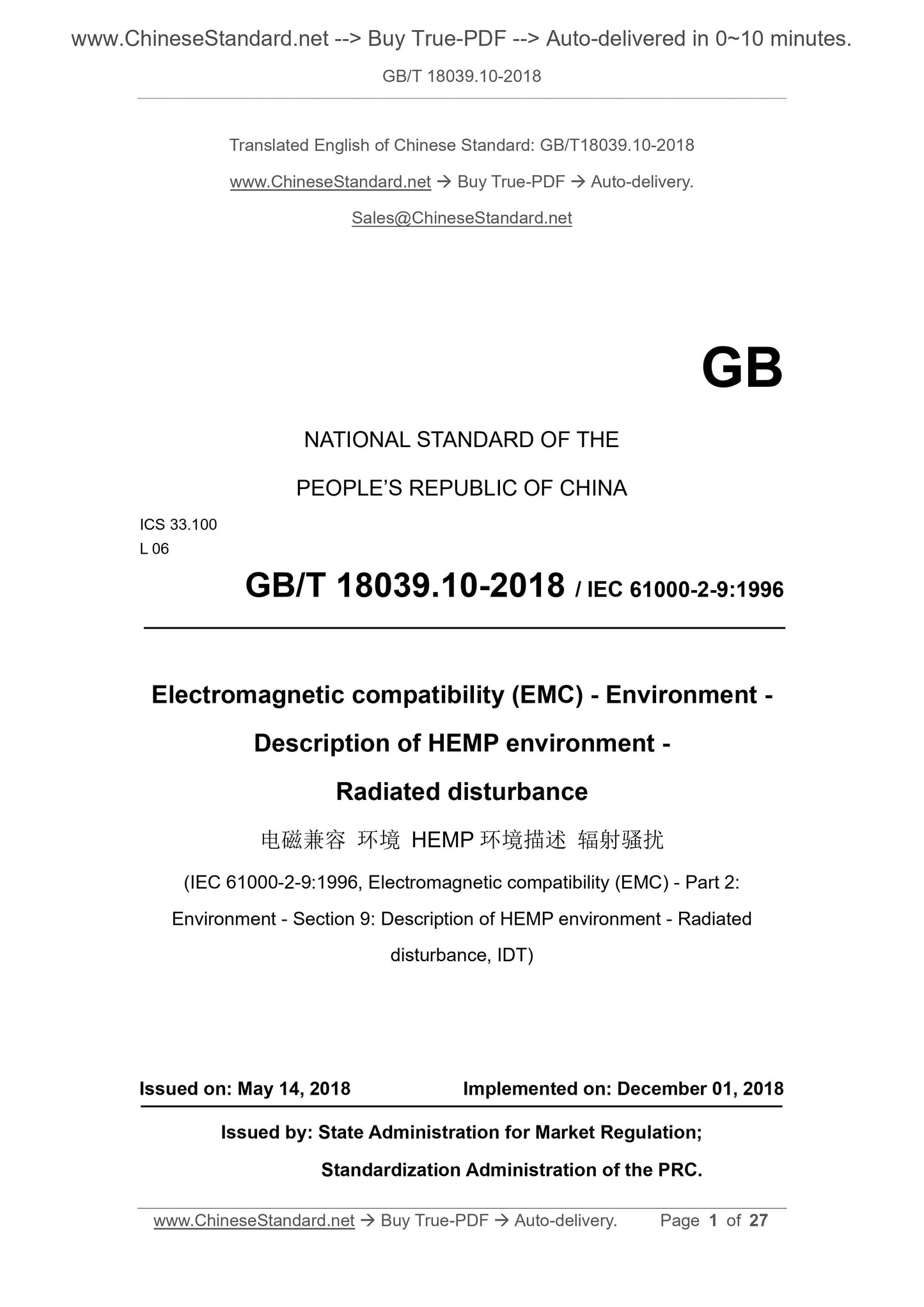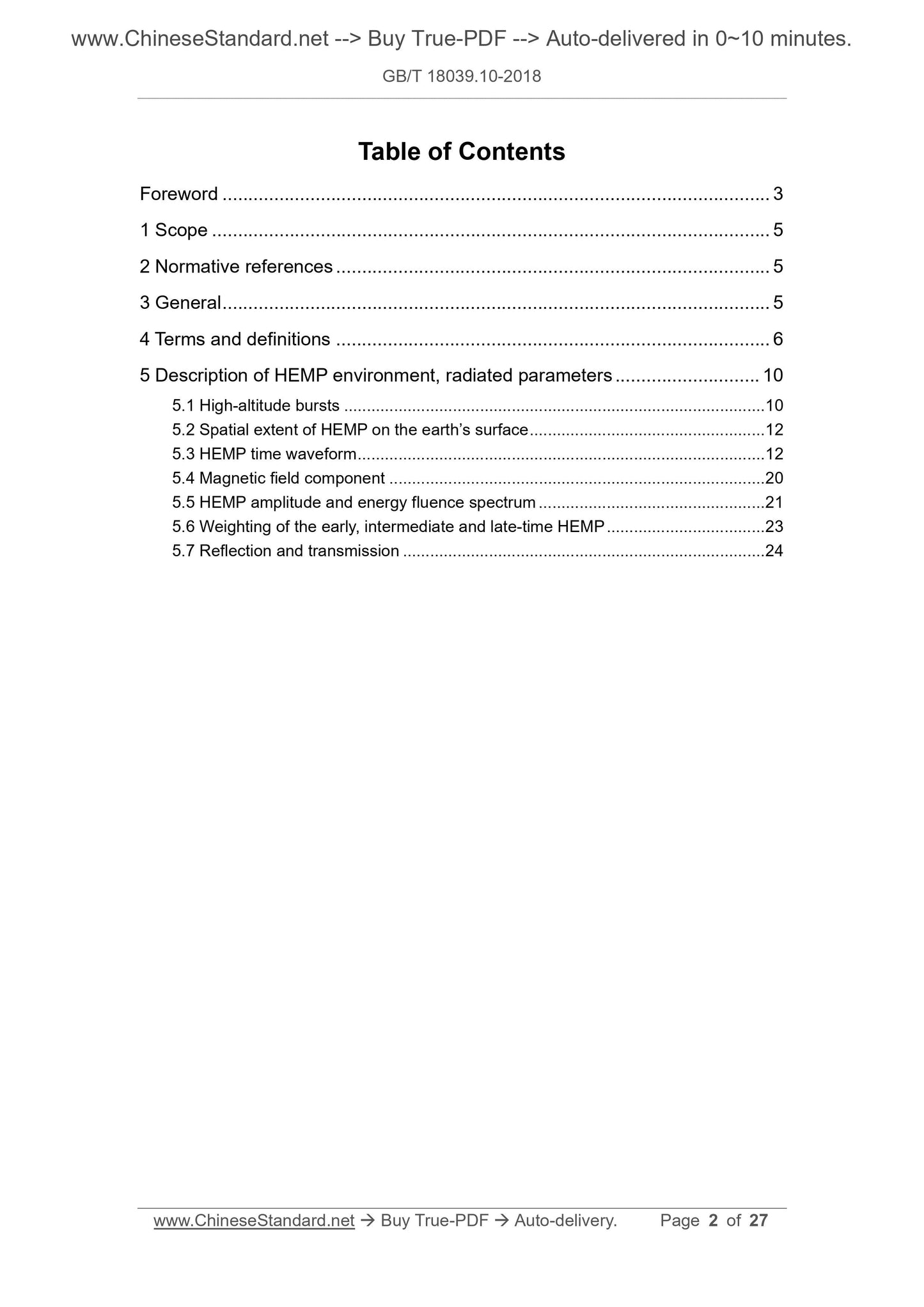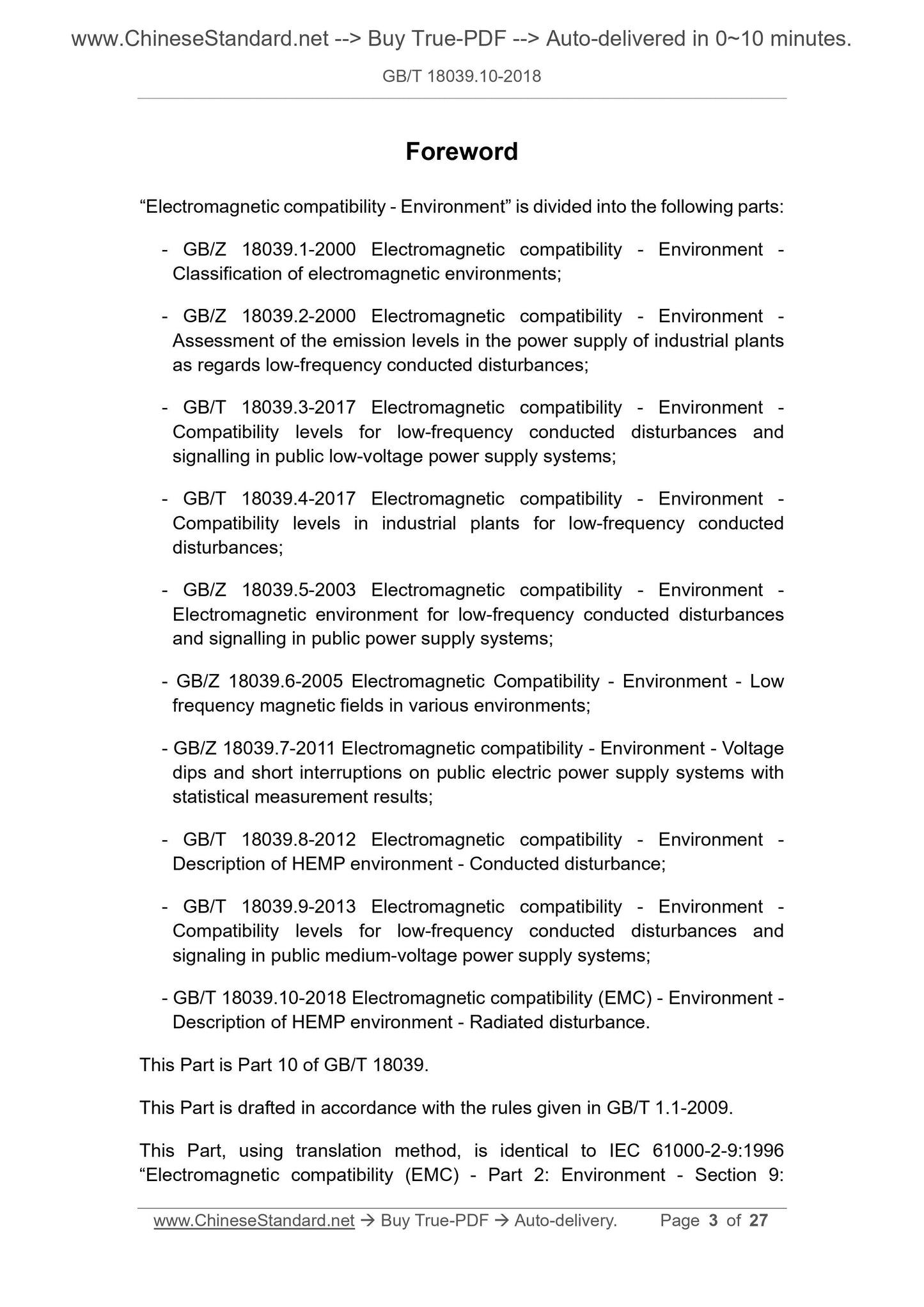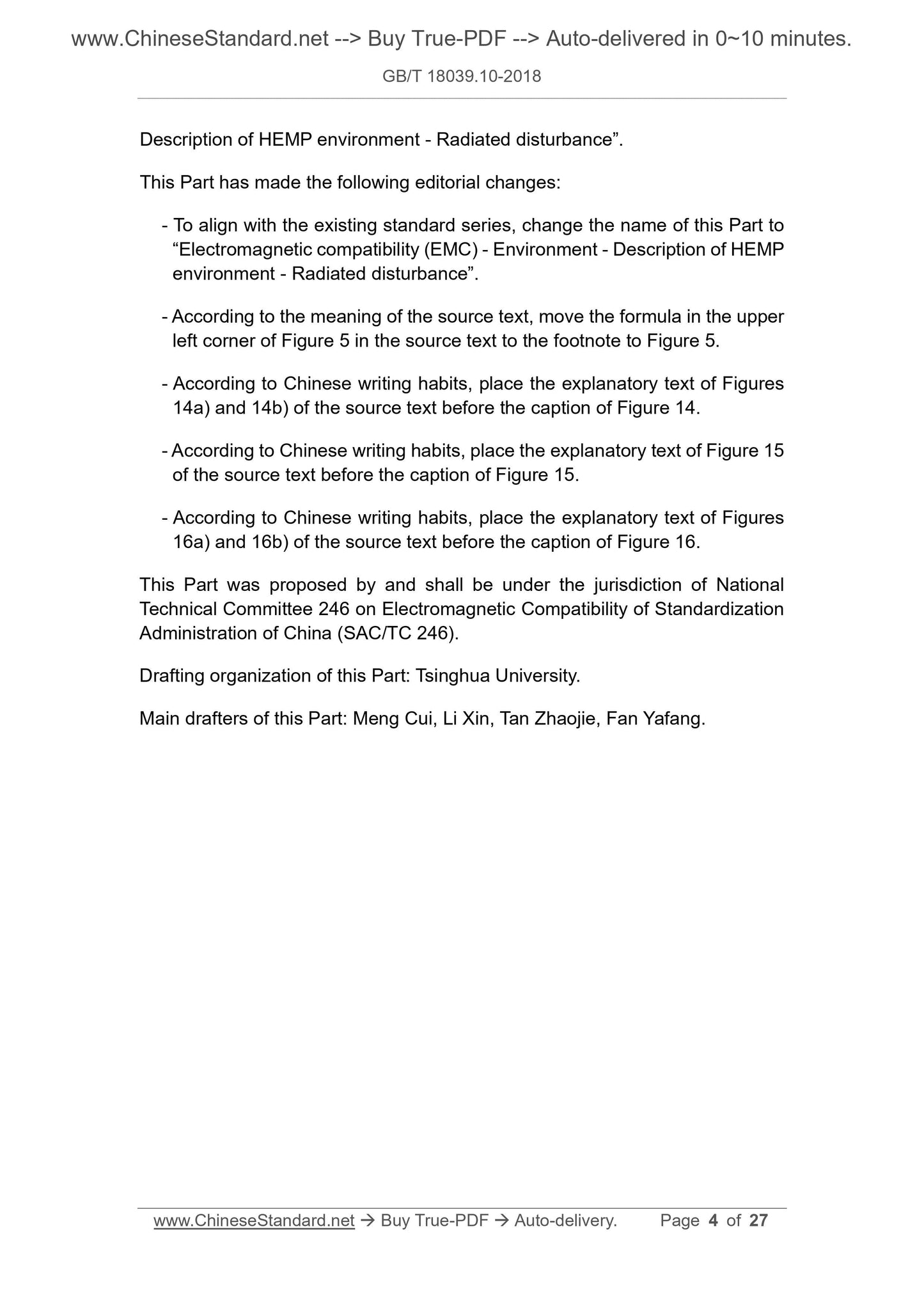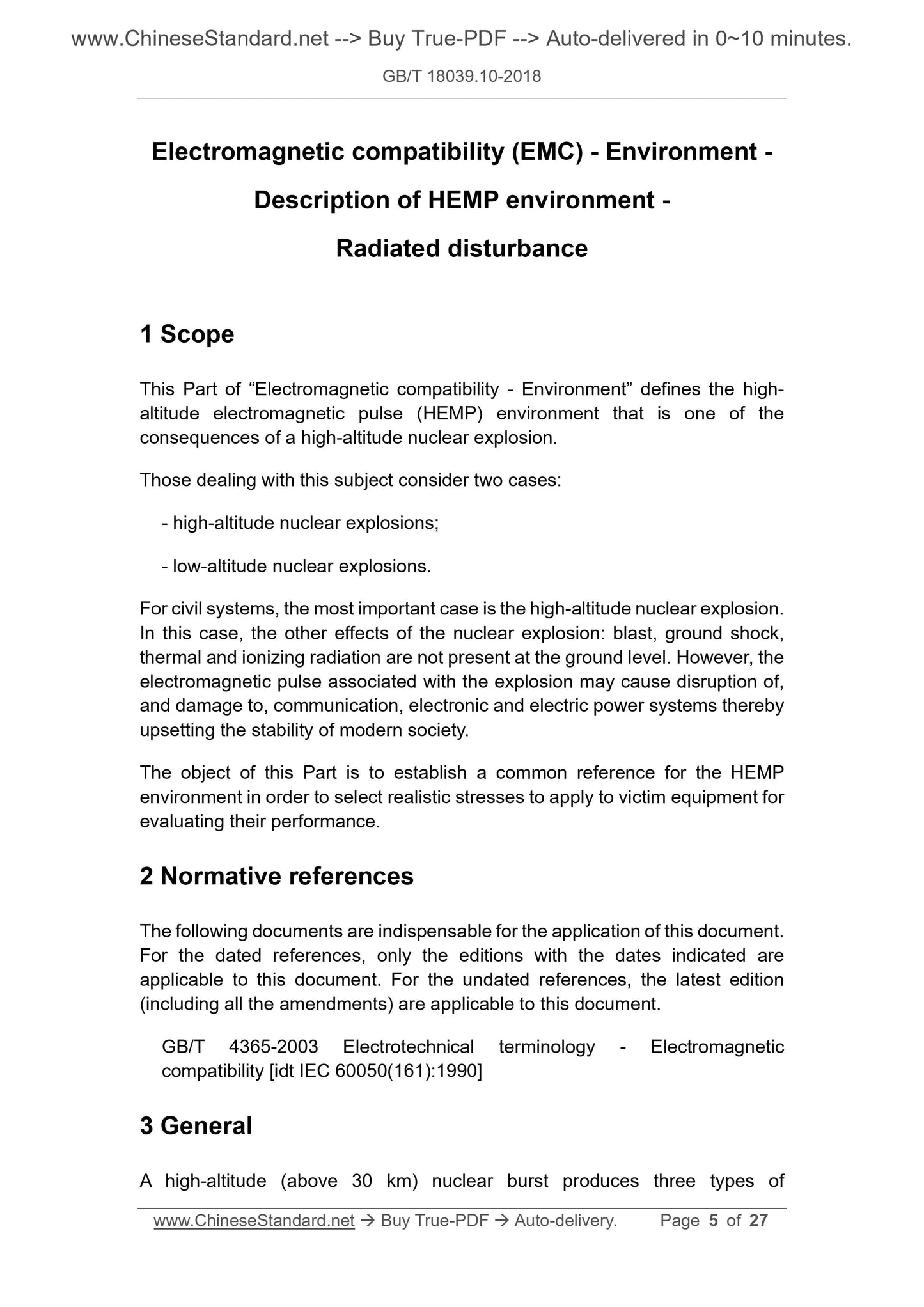1
/
of
5
www.ChineseStandard.us -- Field Test Asia Pte. Ltd.
GB/T 18039.10-2018 English PDF (GB/T18039.10-2018)
GB/T 18039.10-2018 English PDF (GB/T18039.10-2018)
Regular price
$180.00
Regular price
Sale price
$180.00
Unit price
/
per
Shipping calculated at checkout.
Couldn't load pickup availability
GB/T 18039.10-2018: Electromagnetic compatibility (EMC) -- Environment -- Description of HEMP environment -- Radiated disturbance
Delivery: 9 seconds. Download (& Email) true-PDF + Invoice.
Get Quotation: Click GB/T 18039.10-2018 (Self-service in 1-minute)
Historical versions (Master-website): GB/T 18039.10-2018
Preview True-PDF (Reload/Scroll-down if blank)
GB/T 18039.10-2018
Electromagnetic compatibility(EMC)--Environment--Description of HEMP environment--Radiated disturbance
ICS 33.100
L06
National Standards of People's Republic of China
Electromagnetic compatibility environment
HEMP environment describes radiated disturbance
[IEC 61000-2-9.1996, Electromagneticcompatibility (EMC)-
Part 2.Environment-Section9. DescriptionofHEMPenvironment-
Radiateddisturbance, IDT]
Published on.2018-05-14
2018-12-01 implementation
State market supervision and administration
China National Standardization Administration issued
Content
Foreword III
1 range 1
2 Normative references 1
3 Overview 1
4 Terms and Definitions 1
5 Description of high-altitude electromagnetic pulse environment, radiation parameter 4
5.1 High-altitude nuclear explosion 4
5.2 HEMP on the ground scope 5
5.3 HEMP Time Domain Waveform 6
5.4 Magnetic field component 11
5.5 HEMP amplitude spectrum and energy fluence spectrum 11
5.6 Impact weights of early, intermediate and late HEMPs 13
5.7 Reflection and Transmission 13
Foreword
The Electromagnetic Compatibility Environment is divided into the following sections.
---GB /Z 18039.1-2000 Classification of electromagnetic environment in electromagnetic compatibility environment;
---GB /Z 18039.2-2000 Electromagnetic compatibility environment industrial equipment power supply low frequency conducted disturbance emission level assessment;
---GB/T 18039.3-2017 Electromagnetic compatibility environment common low-voltage power supply system low-frequency conduction disturbance and signal transmission
Capacity level
---GB/T 18039.4-2017 Compatibility level of low frequency conducted disturbance in electromagnetic compatibility environment factory;
---GB /Z 18039.5-2003 Electromagnetic compatibility environment public power supply system low frequency conduction disturbance and electromagnetic transmission of signal transmission
surroundings;
---GB /Z 18039.6-2005 Electromagnetic compatibility environment Low frequency magnetic field in various environments;
---GB /Z 18039.7-2011 Electromagnetic compatibility environment, voltage sag, short-term interruption and its measurement system
Counting results
---GB/T 18039.8-2012 Electromagnetic compatibility environment High altitude nuclear electromagnetic pulse (HEMP) environment describes conducted disturbance;
---GB/T 18039.9-2013 Electromagnetic compatibility environment common medium voltage power supply system low frequency conduction disturbance and signal transmission
Capacity level
This part is the 10th part of GB/T 18039.
This part is drafted in accordance with the rules given in GB/T 1.1-2009.
This section uses the translation method equivalent to IEC 61000-2-9.1996 Electromagnetic Compatibility (EMC) Part 2. Environment Section 9.
The HEMP environment describes radiated disturbances.
This section has made the following editorial changes.
--- In line with the existing standard series, change the name of this part to "Electromagnetic compatibility environment HEMP environment describes radiated disturbance".
--- According to the original meaning, move the formula in the upper left corner of the original picture 5 to the footnote of Figure 5.
--- According to Chinese writing habits, the explanatory text of the original texts 14a), 14b) is placed before the figure in Figure 14.
--- According to the Chinese writing habits, the explanatory text of the original text 15 is placed before the figure in Fig. 15.
--- According to Chinese writing habits, the explanatory text of the original texts 16a), 16b) is placed before the figure in Figure 16.
This part is proposed and managed by the National Electromagnetic Compatibility Standardization Technical Committee (SAC/TC246).
This section was drafted by. Tsinghua University.
The main drafters of this section. Meng Cui, Li Xin, Tan Zhaojie, Fan Yafang.
Electromagnetic compatibility environment
HEMP environment describes radiated disturbance
1 Scope
This part of the Electromagnetic Compatibility Environment defines a high altitude electromagnetic pulse (HEMP) environment, one of the effects of high altitude nuclear explosions.
There are two situations to consider when studying this topic.
---High altitude nuclear explosion;
--- Low-altitude nuclear explosion.
For civilian systems, the most serious situation is a high-altitude nuclear explosion. In this case, other effects of nuclear explosions, such as explosions,
Ground impact, heat radiation and ionizing radiation will not affect the ground. However, electromagnetic pulses generated by nuclear explosions may cause communication systems.
Damage and destruction of the system, electronics and power systems, which in turn affects the stability of modern society.
The purpose of this section is to establish a general reference for the HEMP environment, to select the actual environmental parameters for sensitive devices, and to evaluate their sensitivity.
Sensitivity.
2 Normative references
The following documents are indispensable for the application of this document. For dated references, only dated versions apply to this article.
Pieces. For undated references, the latest edition (including all amendments) applies to this document.
GB/T 4365-2003 Electrotechnical terminology electromagnetic compatibility [idtIEC 60050 (161)..1990]
3 Overview
High-altitude (above 30km) nuclear explosions produce three types of electromagnetic pulses that can be observed on the Earth's surface.
--- Early high altitude electromagnetic pulse (fast);
--- Medium-term high altitude electromagnetic pulse (medium);
--- Late high altitude electromagnetic pulse (slow).
Historically, most of the attention has been focused on early high-altitude electromagnetic pulses, which once briefly recognized high-altitude electromagnetic pulses.
It means the early high-altitude electromagnetic pulse. And here, the term "high altitude EMP" or "HEMP" we use will include all three types of electricity.
Magnetic pulse. The term nuclear electromagnetic pulse (NEMP1) covers many categories, including nuclear electromagnetic pulses in the source region generated by ground nuclear explosions.
(SREMP2)) and system electromagnetic pulse (SGEMP3) excited in the space system.
Since high-altitude electromagnetic pulses (HEMP) are generated by high-altitude nuclear explosions, there will be no other nuclear weapons effects on the ground, such as gamma rays, heat.
Radiation, shock waves, etc. In the early 1960s, the United States conducted high-altitude nuclear explosion tests in the South Pacific, resulting in electronic settings far from the explosion point.
For the first time in the report of the huge effect, the term high-altitude electromagnetic pulse (HEMP) appeared.
1) NEMP. Nuclear electromagnetic pulse.
2) SREMP. Nuclear electromagnetic pulse in the source area.
3) SGEMP. System electromagnetic pulse.
4 Terms and definitions
The following terms and definitions as defined in GB/T 4365-2003 apply to this document.
4.1
Vertical plane elevation angleangleoflevationintheverticalplane
In the vertical plane of the horizontal plane, the angle between the direction of propagation and the horizontal plane (ground plane) (see Figure 1).
Figure 1 Definition of polarization, elevation angle Ψ and azimuth Φ
4.2
Azimuth azimuthangle
The projection of the propagation direction on the ground plane is at an angle to the principal axis of the target (the Z axis for the transmission line in Figure 1).
4.3
Composite waveform compositewaveform
A waveform that maximizes the most important features of a set of waveforms.
4.4
Coupling coupling
High-altitude electromagnetic pulses interact with the system to generate current and voltage across the system surface and cables. The voltage is generated by the induced charge, only
Meaning low frequency and wavelength is greater than surface or gap size.
4.5
Direction of electromagnetic wave propagation directionofpropagationoftheelectromagneticwave
Propagation vector k
The direction of → is perpendicular to the plane of the electric and magnetic field vectors (see Figure 2).
Figure 2 Geometric definition of plane waves
4.6
E1, E2, E3
Refers to the electric fields of the early, middle and late high altitude electromagnetic pulses, respectively.
4.7
Electromagnetic pulse electromagneticpulse; EMP
Any electromagnetic pulse, collectively.
4.8
Energy flow
The time integral of the Poynting vector, in J/m2.
4.9
Geomagnetic dip geomagneticdipangle
Θdip
The inclination of the earth's magnetic flux flux density vector B→e, that is, the angle between the north-south plane and the horizontal plane where the magnetic field is located at the point, in the north magnetic field
Θdip=90°, in the south of the earth's magnetic field is θdip=-90° (see Figure 3).
Figure 3 Earth magnetic field dip
4.10
Ground floor projection point groundzero
A point at which a heart bursts vertically onto the surface of the earth, sometimes referred to as a surface zero.
4.11
HEMP high-altitudenuclearEMP
High altitude electromagnetic pulse.
4.12
High altitude (nuclear explosion) high-altitude(nuclearexplosion)
Explosion with a height of more than 30km.
4.13
Core height burstofburst; HOB
The height of the heart.
4.14
Horizontal polarization horizontalpolarization
If an electromagnetic wave has a magnetic field vector at the incident surface and the electric field vector is perpendicular to the incident surface and parallel to the ground plane, it is called the horizontal pole.
(Figure 1). This polarization field is also known as the transverse electric field (TE).
4.15
Incident plane incubationplane
A plane formed by the propagation vector and the normal to the ground plane.
4.16
Low-altitude (nuclearexplosion)
A nuclear explosion with a height of less than 1km.
4.17
Nuclear electromagnetic pulse nuclearEMP; NEMP
A general term for all types of electromagnetic pulses generated by nuclear explosions.
4.18
Polarization polarization
Electric field vector direction.
4.19
Instant radiation
Nuclear energy radiated within 1 μs after the explosion.
4.20
Source area electromagnetic pulse sourceregionEMP; SREMP
A nuclear electromagnetic pulse generated by a transient radiation that excites a current (source) in the air.
4.21
Cut point tangentpoint
A little on the surface of the earth, from the heart to the surface of the earth, a tangent to the intersection of the tangent and the earth.
4.22
Tangential radius
The length of the point along the surface of the earth projected from the ground floor to any point.
4.23
Vertical polarization verticalpolarization
If an electromagnetic wave has an electric field vector at the incident surface and the magnetic field vector is perpendicular to the incident surface and parallel to the ground plane, it is called a vertical pole.
(Figure 1). This polarization field is also known as the transverse magnetic field (TM).
5 Description of high-altitude electromagnetic pulse environment, radiation parameters
5.1 High-altitude nuclear explosion
When a nuclear weapon explodes at high altitude, most of the instantaneous radiation (such as X-rays, gamma rays, and neutrons) generated by the explosion is below the heart.
High density atmospheric deposition. In the deposition zone (also known as the source zone), gamma rays react with air molecules to produce Compton electrons.
These moving electrons deflect under the action of the Earth's magnetic field, producing a lateral current that produces a transverse electric field and propagates to the Earth.
surface. The above mechanism describes the production process of early HEMP, as shown in Figure 4. The description parameters of the early HEMP are as follows. peak field strength
Large (tens of kilovolts per meter), fast rising front (several nanoseconds), short duration (up to 100ns), and wave impedance of 377Ω. Early HEMP spoke
The range of the shot is the surface of the earth within the range of the blasting field. The direction of polarization of the electric field and its direction of propagation and the direction of the local geomagnetic field in the sedimentary zone
straight. In the northern and southern hemispheres far enough away from the equator, the polarization direction of the early HEMP electric field is almost horizontal.
Immediately following the early fast HEMP transient pulse, additional ionization occurs from the scattered gamma rays and hard gamma rays generated by the explosive radiation neutrons.
The second part (interim) HEMP signal is generated. The amplitude of this part of the signal is in the range of 10V/m to 100V/m and the duration is 100ns.
To tens of milliseconds.
The last part of the HEMP signal, the late HEMP, is also known as the magnetohydrodynamic electromagnetic pulse (MHD-EMP). Late
The HEMP electric field has a small amplitude (tens of V/m), a rising front (several seconds), and a long duration (several hundred seconds). It will be in the power line network and communication network
Current is induced on the network, and its effects are closely related to solar magnetic storms in power lines and communication networks in countries such as Canada and Northern Europe.
The effect on the above is similar. Late HEMP interacts with the communication network and the grid to generate induced currents that will cause harmonic and phase imbalances.
This can cause damage to major power system components such as transformers.
Figure 4 High-altitude nuclear explosion produces early HEMP diagram
5.2 HEMP on the ground
At high altitude nuclear explosions, the extent of HEMP's action on the ground depends on the explosion height and explosive equivalent. At different locations within the scope of action
Observed electric field signals vary widely (such as peak, rise time, duration, or polarization), for example, high altitude nucleus in the northern hemisphere
Explosion, the maximum peak electric field (denoted as Emax) appears on the south side of the ground-breaking ground projection point, up to 50kV/m (this value depends on the explosion height and explosion
Fried equivalent). Figu...
Delivery: 9 seconds. Download (& Email) true-PDF + Invoice.
Get Quotation: Click GB/T 18039.10-2018 (Self-service in 1-minute)
Historical versions (Master-website): GB/T 18039.10-2018
Preview True-PDF (Reload/Scroll-down if blank)
GB/T 18039.10-2018
Electromagnetic compatibility(EMC)--Environment--Description of HEMP environment--Radiated disturbance
ICS 33.100
L06
National Standards of People's Republic of China
Electromagnetic compatibility environment
HEMP environment describes radiated disturbance
[IEC 61000-2-9.1996, Electromagneticcompatibility (EMC)-
Part 2.Environment-Section9. DescriptionofHEMPenvironment-
Radiateddisturbance, IDT]
Published on.2018-05-14
2018-12-01 implementation
State market supervision and administration
China National Standardization Administration issued
Content
Foreword III
1 range 1
2 Normative references 1
3 Overview 1
4 Terms and Definitions 1
5 Description of high-altitude electromagnetic pulse environment, radiation parameter 4
5.1 High-altitude nuclear explosion 4
5.2 HEMP on the ground scope 5
5.3 HEMP Time Domain Waveform 6
5.4 Magnetic field component 11
5.5 HEMP amplitude spectrum and energy fluence spectrum 11
5.6 Impact weights of early, intermediate and late HEMPs 13
5.7 Reflection and Transmission 13
Foreword
The Electromagnetic Compatibility Environment is divided into the following sections.
---GB /Z 18039.1-2000 Classification of electromagnetic environment in electromagnetic compatibility environment;
---GB /Z 18039.2-2000 Electromagnetic compatibility environment industrial equipment power supply low frequency conducted disturbance emission level assessment;
---GB/T 18039.3-2017 Electromagnetic compatibility environment common low-voltage power supply system low-frequency conduction disturbance and signal transmission
Capacity level
---GB/T 18039.4-2017 Compatibility level of low frequency conducted disturbance in electromagnetic compatibility environment factory;
---GB /Z 18039.5-2003 Electromagnetic compatibility environment public power supply system low frequency conduction disturbance and electromagnetic transmission of signal transmission
surroundings;
---GB /Z 18039.6-2005 Electromagnetic compatibility environment Low frequency magnetic field in various environments;
---GB /Z 18039.7-2011 Electromagnetic compatibility environment, voltage sag, short-term interruption and its measurement system
Counting results
---GB/T 18039.8-2012 Electromagnetic compatibility environment High altitude nuclear electromagnetic pulse (HEMP) environment describes conducted disturbance;
---GB/T 18039.9-2013 Electromagnetic compatibility environment common medium voltage power supply system low frequency conduction disturbance and signal transmission
Capacity level
This part is the 10th part of GB/T 18039.
This part is drafted in accordance with the rules given in GB/T 1.1-2009.
This section uses the translation method equivalent to IEC 61000-2-9.1996 Electromagnetic Compatibility (EMC) Part 2. Environment Section 9.
The HEMP environment describes radiated disturbances.
This section has made the following editorial changes.
--- In line with the existing standard series, change the name of this part to "Electromagnetic compatibility environment HEMP environment describes radiated disturbance".
--- According to the original meaning, move the formula in the upper left corner of the original picture 5 to the footnote of Figure 5.
--- According to Chinese writing habits, the explanatory text of the original texts 14a), 14b) is placed before the figure in Figure 14.
--- According to the Chinese writing habits, the explanatory text of the original text 15 is placed before the figure in Fig. 15.
--- According to Chinese writing habits, the explanatory text of the original texts 16a), 16b) is placed before the figure in Figure 16.
This part is proposed and managed by the National Electromagnetic Compatibility Standardization Technical Committee (SAC/TC246).
This section was drafted by. Tsinghua University.
The main drafters of this section. Meng Cui, Li Xin, Tan Zhaojie, Fan Yafang.
Electromagnetic compatibility environment
HEMP environment describes radiated disturbance
1 Scope
This part of the Electromagnetic Compatibility Environment defines a high altitude electromagnetic pulse (HEMP) environment, one of the effects of high altitude nuclear explosions.
There are two situations to consider when studying this topic.
---High altitude nuclear explosion;
--- Low-altitude nuclear explosion.
For civilian systems, the most serious situation is a high-altitude nuclear explosion. In this case, other effects of nuclear explosions, such as explosions,
Ground impact, heat radiation and ionizing radiation will not affect the ground. However, electromagnetic pulses generated by nuclear explosions may cause communication systems.
Damage and destruction of the system, electronics and power systems, which in turn affects the stability of modern society.
The purpose of this section is to establish a general reference for the HEMP environment, to select the actual environmental parameters for sensitive devices, and to evaluate their sensitivity.
Sensitivity.
2 Normative references
The following documents are indispensable for the application of this document. For dated references, only dated versions apply to this article.
Pieces. For undated references, the latest edition (including all amendments) applies to this document.
GB/T 4365-2003 Electrotechnical terminology electromagnetic compatibility [idtIEC 60050 (161)..1990]
3 Overview
High-altitude (above 30km) nuclear explosions produce three types of electromagnetic pulses that can be observed on the Earth's surface.
--- Early high altitude electromagnetic pulse (fast);
--- Medium-term high altitude electromagnetic pulse (medium);
--- Late high altitude electromagnetic pulse (slow).
Historically, most of the attention has been focused on early high-altitude electromagnetic pulses, which once briefly recognized high-altitude electromagnetic pulses.
It means the early high-altitude electromagnetic pulse. And here, the term "high altitude EMP" or "HEMP" we use will include all three types of electricity.
Magnetic pulse. The term nuclear electromagnetic pulse (NEMP1) covers many categories, including nuclear electromagnetic pulses in the source region generated by ground nuclear explosions.
(SREMP2)) and system electromagnetic pulse (SGEMP3) excited in the space system.
Since high-altitude electromagnetic pulses (HEMP) are generated by high-altitude nuclear explosions, there will be no other nuclear weapons effects on the ground, such as gamma rays, heat.
Radiation, shock waves, etc. In the early 1960s, the United States conducted high-altitude nuclear explosion tests in the South Pacific, resulting in electronic settings far from the explosion point.
For the first time in the report of the huge effect, the term high-altitude electromagnetic pulse (HEMP) appeared.
1) NEMP. Nuclear electromagnetic pulse.
2) SREMP. Nuclear electromagnetic pulse in the source area.
3) SGEMP. System electromagnetic pulse.
4 Terms and definitions
The following terms and definitions as defined in GB/T 4365-2003 apply to this document.
4.1
Vertical plane elevation angleangleoflevationintheverticalplane
In the vertical plane of the horizontal plane, the angle between the direction of propagation and the horizontal plane (ground plane) (see Figure 1).
Figure 1 Definition of polarization, elevation angle Ψ and azimuth Φ
4.2
Azimuth azimuthangle
The projection of the propagation direction on the ground plane is at an angle to the principal axis of the target (the Z axis for the transmission line in Figure 1).
4.3
Composite waveform compositewaveform
A waveform that maximizes the most important features of a set of waveforms.
4.4
Coupling coupling
High-altitude electromagnetic pulses interact with the system to generate current and voltage across the system surface and cables. The voltage is generated by the induced charge, only
Meaning low frequency and wavelength is greater than surface or gap size.
4.5
Direction of electromagnetic wave propagation directionofpropagationoftheelectromagneticwave
Propagation vector k
The direction of → is perpendicular to the plane of the electric and magnetic field vectors (see Figure 2).
Figure 2 Geometric definition of plane waves
4.6
E1, E2, E3
Refers to the electric fields of the early, middle and late high altitude electromagnetic pulses, respectively.
4.7
Electromagnetic pulse electromagneticpulse; EMP
Any electromagnetic pulse, collectively.
4.8
Energy flow
The time integral of the Poynting vector, in J/m2.
4.9
Geomagnetic dip geomagneticdipangle
Θdip
The inclination of the earth's magnetic flux flux density vector B→e, that is, the angle between the north-south plane and the horizontal plane where the magnetic field is located at the point, in the north magnetic field
Θdip=90°, in the south of the earth's magnetic field is θdip=-90° (see Figure 3).
Figure 3 Earth magnetic field dip
4.10
Ground floor projection point groundzero
A point at which a heart bursts vertically onto the surface of the earth, sometimes referred to as a surface zero.
4.11
HEMP high-altitudenuclearEMP
High altitude electromagnetic pulse.
4.12
High altitude (nuclear explosion) high-altitude(nuclearexplosion)
Explosion with a height of more than 30km.
4.13
Core height burstofburst; HOB
The height of the heart.
4.14
Horizontal polarization horizontalpolarization
If an electromagnetic wave has a magnetic field vector at the incident surface and the electric field vector is perpendicular to the incident surface and parallel to the ground plane, it is called the horizontal pole.
(Figure 1). This polarization field is also known as the transverse electric field (TE).
4.15
Incident plane incubationplane
A plane formed by the propagation vector and the normal to the ground plane.
4.16
Low-altitude (nuclearexplosion)
A nuclear explosion with a height of less than 1km.
4.17
Nuclear electromagnetic pulse nuclearEMP; NEMP
A general term for all types of electromagnetic pulses generated by nuclear explosions.
4.18
Polarization polarization
Electric field vector direction.
4.19
Instant radiation
Nuclear energy radiated within 1 μs after the explosion.
4.20
Source area electromagnetic pulse sourceregionEMP; SREMP
A nuclear electromagnetic pulse generated by a transient radiation that excites a current (source) in the air.
4.21
Cut point tangentpoint
A little on the surface of the earth, from the heart to the surface of the earth, a tangent to the intersection of the tangent and the earth.
4.22
Tangential radius
The length of the point along the surface of the earth projected from the ground floor to any point.
4.23
Vertical polarization verticalpolarization
If an electromagnetic wave has an electric field vector at the incident surface and the magnetic field vector is perpendicular to the incident surface and parallel to the ground plane, it is called a vertical pole.
(Figure 1). This polarization field is also known as the transverse magnetic field (TM).
5 Description of high-altitude electromagnetic pulse environment, radiation parameters
5.1 High-altitude nuclear explosion
When a nuclear weapon explodes at high altitude, most of the instantaneous radiation (such as X-rays, gamma rays, and neutrons) generated by the explosion is below the heart.
High density atmospheric deposition. In the deposition zone (also known as the source zone), gamma rays react with air molecules to produce Compton electrons.
These moving electrons deflect under the action of the Earth's magnetic field, producing a lateral current that produces a transverse electric field and propagates to the Earth.
surface. The above mechanism describes the production process of early HEMP, as shown in Figure 4. The description parameters of the early HEMP are as follows. peak field strength
Large (tens of kilovolts per meter), fast rising front (several nanoseconds), short duration (up to 100ns), and wave impedance of 377Ω. Early HEMP spoke
The range of the shot is the surface of the earth within the range of the blasting field. The direction of polarization of the electric field and its direction of propagation and the direction of the local geomagnetic field in the sedimentary zone
straight. In the northern and southern hemispheres far enough away from the equator, the polarization direction of the early HEMP electric field is almost horizontal.
Immediately following the early fast HEMP transient pulse, additional ionization occurs from the scattered gamma rays and hard gamma rays generated by the explosive radiation neutrons.
The second part (interim) HEMP signal is generated. The amplitude of this part of the signal is in the range of 10V/m to 100V/m and the duration is 100ns.
To tens of milliseconds.
The last part of the HEMP signal, the late HEMP, is also known as the magnetohydrodynamic electromagnetic pulse (MHD-EMP). Late
The HEMP electric field has a small amplitude (tens of V/m), a rising front (several seconds), and a long duration (several hundred seconds). It will be in the power line network and communication network
Current is induced on the network, and its effects are closely related to solar magnetic storms in power lines and communication networks in countries such as Canada and Northern Europe.
The effect on the above is similar. Late HEMP interacts with the communication network and the grid to generate induced currents that will cause harmonic and phase imbalances.
This can cause damage to major power system components such as transformers.
Figure 4 High-altitude nuclear explosion produces early HEMP diagram
5.2 HEMP on the ground
At high altitude nuclear explosions, the extent of HEMP's action on the ground depends on the explosion height and explosive equivalent. At different locations within the scope of action
Observed electric field signals vary widely (such as peak, rise time, duration, or polarization), for example, high altitude nucleus in the northern hemisphere
Explosion, the maximum peak electric field (denoted as Emax) appears on the south side of the ground-breaking ground projection point, up to 50kV/m (this value depends on the explosion height and explosion
Fried equivalent). Figu...
Share
